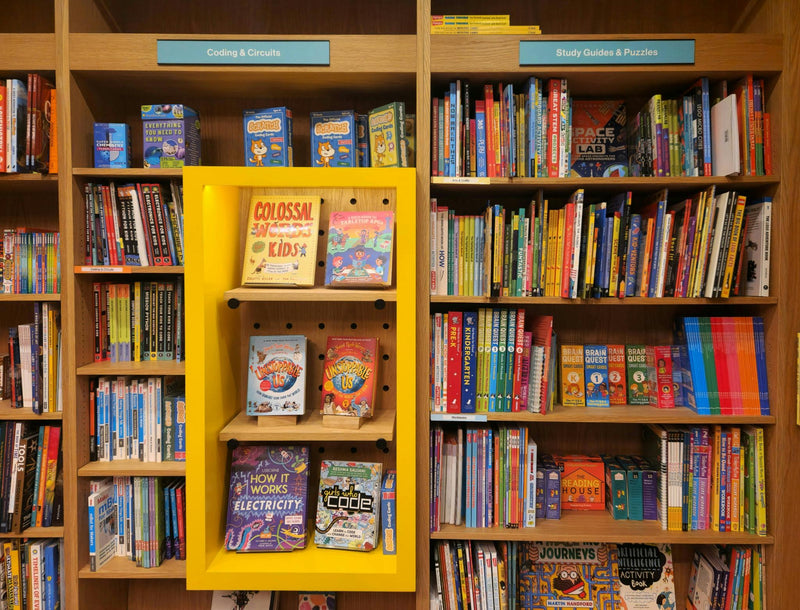
The Magic Formula: What Makes Children's Books Absolutely Irresistible to Young Readers 📚✨
Picture this: a child who usually resists bedtime suddenly begging for "just one more chapter." A reluctant reader who discovers a book series and devours every single volume. A preschooler who memorizes their favorite story and "reads" it to anyone who will listen. What transforms books from educational tools into magical portals that children can't put down? The answer lies in understanding what truly captivates young minds and hearts. 🌟👧🏽👦🏾
The Secret Ingredients: What Children Crave in Their Books 🧙♀️📖
After years of watching children interact with countless stories, certain patterns emerge about what makes books absolutely irresistible to young readers. It's not always what adults might expect!
Children gravitate toward books that:
- Feature characters who feel like real friends (even if they're animals!) 🐾❤️
- Include problems they can relate to or wish they could solve 🧩💭
- Have just enough challenge to feel grown-up but not overwhelming 📈🌱
- Contain humor that speaks to their developmental stage 😂🎭
- Offer predictable elements alongside delightful surprises 🔄✨
- Include illustrations that enhance rather than distract from the story 🎨📚
The My Furry Soulmates series exemplifies many of these qualities through engaging animal characters who face relatable challenges while maintaining that perfect balance of familiarity and excitement. 🦊📚
The Power of Relatable Characters: Why Animals Often Win Hearts 🐻❤️
One fascinating trend in children's literature is the enduring appeal of animal characters. But why do children often connect more deeply with a brave mouse or a curious cat than with human characters?
Animal characters offer unique advantages:
- They feel safer for exploring difficult emotions 🛡️💭
- Children can project themselves onto them without self-consciousness 🎭👧🏻
- They can have adventures that would be unrealistic for human children 🚀🌍
- They transcend cultural and demographic boundaries 🌈🤝
- They often embody single, clear personality traits that children can easily understand 🎯🧠
Animal protagonists also allow children to explore complex themes like friendship, courage, and problem-solving without the added layer of human social dynamics that might feel too close to home.
The Confident Mindset Journal recognizes this connection by incorporating animal imagery and metaphors that help children explore their own confidence-building journey. 📔🦋
Age-Appropriate Themes That Captivate Different Developmental Stages 👶🏽➡️👦🏼
What fascinates a three-year-old differs dramatically from what engages a seven-year-old. Understanding these developmental preferences helps explain why certain books become instant favorites:
Early Childhood (Ages 2-4): The Wonder Years 🌟
- Favorite themes: Daily routines, family relationships, cause and effect
- Appealing elements: Repetitive text, rhyming, sensory details
- Character preferences: Gentle animals, familiar family figures
- Conflict level: Very mild challenges with quick, happy resolutions
Preschool (Ages 4-5): The Explorer Stage 🧭
- Favorite themes: Friendship, starting school, trying new things
- Appealing elements: Interactive elements, humor, simple moral lessons
- Character preferences: Brave but relatable protagonists
- Conflict level: Small obstacles that characters overcome through effort
Early Elementary (Ages 6-8): The Adventurer Phase 🚀
- Favorite themes: Justice, problem-solving, belonging, growing independence
- Appealing elements: Series potential, mild suspense, character growth
- Character preferences: Heroes who make mistakes but learn from them
- Conflict level: Real challenges with satisfying, earned resolutions
The structured activities in the Curiosity Mindset Journal tap into this natural progression, encouraging children to explore increasingly complex questions as they grow. 🔍✨
The Humor Factor: Why Children Need Books That Make Them Laugh 😄📚
Never underestimate the power of humor in children's literature! Laughter doesn't just make reading fun—it serves crucial developmental purposes:
Why humor matters in children's books:
- It creates positive associations with reading 😊📖
- It helps children process difficult emotions safely 🎭❤️
- It builds social connections when shared with others 👫🤝
- It demonstrates that learning can be joyful 🎉🧠
- It helps children remember storylines and lessons better 💭✨
Age-appropriate humor looks different at each stage:
- Toddlers: Physical comedy, silly sounds, unexpected outcomes
- Preschoolers: Wordplay, gentle absurdity, characters doing "wrong" things
- Early elementary: Mild mischief, clever solutions, character quirks
The key is humor that feels authentic to children's experiences rather than adult attempts to be "kid-friendly."
Visual Storytelling: The Art of Perfect Picture-Text Balance 🎨📝
In our increasingly visual world, the relationship between illustrations and text has become more important than ever. Children are sophisticated visual consumers who notice when images truly enhance a story versus when they feel like afterthoughts.
Elements of compelling visual storytelling:
- Illustrations that add emotional depth to the narrative 🎭💫
- Visual details that reward careful observation 🔍👀
- Art styles that match the story's tone and energy ⚡🎨
- Character expressions that help children read emotions 😊😢😤
- Environmental details that create immersive story worlds 🌍🏠
Visual elements children particularly love:
- Characters with expressive eyes and faces 👁️😊
- Rich, detailed backgrounds they can explore 🌳🏰
- Consistent character design that helps them follow the story 🔄👱♀️
- Art that shows rather than tells emotional moments 💭❤️
The Series Effect: Why Children Crave Familiar Worlds 🌟🔄
There's a reason children often become obsessed with book series—returning to familiar characters and worlds offers unique psychological benefits:
Why series appeal to young readers:
- They provide comfort through predictability 🏠❤️
- They allow deeper character development over time 📈👧🏾
- They create anticipation and excitement for what's next 🎁⏰
- They help children feel like experts in a particular story world 🧠🏆
- They offer extended practice with similar vocabulary and themes 📚💪
The My Furry Soulmates series leverages this appeal by creating a cohesive world where children can follow different animal characters through various adventures and life lessons. 🦊📚
Interactive and Educational Elements: Learning Disguised as Fun 🎓🎮
Modern children's books often incorporate interactive elements that transform passive reading into active engagement. But the key is making these elements feel integral to the story rather than forced educational add-ons.
Successful interactive elements include:
- Questions that encourage prediction and critical thinking 🤔💭
- Activities that extend the story's themes into real life 🏡✨
- Vocabulary introduced naturally through context 📝🌱
- Moral lessons embedded in character actions rather than preached directly 🎭💡
The Kindness Mindset Journal demonstrates this approach by combining engaging prompts with meaningful character development activities that don't feel like schoolwork. 📔💕
Emotional Safety: Creating Brave Spaces for Big Feelings 🛡️💗
Children are drawn to books that help them navigate their emotional worlds safely. The most beloved children's literature acknowledges that young people experience complex feelings while providing frameworks for understanding and managing them.
Emotionally safe children's books:
- Validate children's feelings as normal and important 💭✅
- Show characters working through difficulties rather than avoiding them 💪🌈
- Offer hope without minimizing real challenges 🌅⚖️
- Demonstrate healthy ways to express and cope with emotions 😊😢😡
- Include diverse emotional experiences that reflect real childhood 🌍❤️
Books become treasured when children feel seen and understood through the characters' experiences.
The Magic of Choice: Honoring Children's Preferences 🎯👧🏻👦🏿
Perhaps the most important factor in creating book-loving children is honoring their individual preferences and choices. What captivates one child may bore another, and that's perfectly normal!
Ways to honor children's reading preferences:
- Offer variety in genres, formats, and complexity levels 📚🌈
- Allow children to reread favorite books as many times as they want 🔄❤️
- Accept that some books won't resonate, and that's okay 🤷♀️✨
- Pay attention to what themes and characters consistently appeal to each child 👀💡
- Remember that "easy" books aren't inferior to "challenging" ones 📈🏆
The Confident Mindset Journal encourages this individualized approach by offering various types of prompts and activities that children can adapt to their own interests and developmental levels. ✏️🌟
Starting Today: Choosing Books Children Will Actually Love 👣📚
Ready to help the children in your life discover their next favorite book? Consider these practical approaches:
- Observe their play themes—children often gravitate toward books that mirror their imaginative play 🎭👀
- Ask open-ended questions about what they liked in previous favorites 🤔💬
- Browse together rather than selecting books independently 👫📖
- Consider multi-sensory elements for reluctant readers 👂👁️✋
- Don't underestimate the power of recommendations from other children 👧🏽➡️👦🏾
- Mix familiar comfort reads with new adventures 🔄🚀
- Pay attention to their questions and interests throughout daily life 🧐📝
Join Our Young Reader Conversation! 💬❤️
What books have absolutely captivated the children in your life? What themes, characters, or elements seem to create those magical "just one more page" moments? Share your experiences in the comments below!
Remember: The goal isn't to create children who read the "right" books—it's to nurture children who associate reading with joy, discovery, and emotional connection. When we understand what naturally appeals to young minds and hearts, we can guide them toward books that will spark a lifelong love of stories. After all, a child who loves reading today becomes an adult who seeks wisdom, empathy, and imagination through books tomorrow. ✨🌟



0 comments